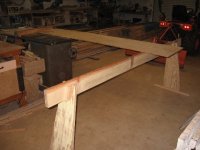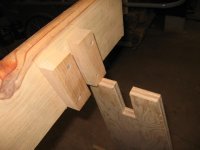patrick_g said:
RedDirt, Very interesting collection of hints. The washer spacer pencil thing and the sawhorse parallel to the saw blade were the only ones that I haven't used at one time or another in one form or another.
Maybe you could give a little more detail on the sawhorse thingy. I struggle quite a lot trying to get full sheets of 3/4 MDf onto my table saw. The table with 52inch extension handles a full sheet nicely but I don't handle it so nicely getting it up there and handling it as it comes off the back side is a hassle. I have the adjustable roller stands on tripods and sometimes they help and sometimes they are in the way or get knocked over.
Pat
Pat, Here is a photo to show the set up. The second photo is a close up of the leg detail of the horse.
The picture shows just a 16" wide x 8ft piece of ply on the saw table but you get the idea. (No, the lights on the tractor are not "on"; it's the flash of the camera.)


Now a 4x8x3/4 sheet of MDF is a tidy load indeed. For this heavy of a sheet I will have the saw off, place the ply on the ground, on edge, in front of the saw, and tilt/lift it onto the saw table and horse. I'll push it tight to the fence and position it just in front of the blade. The full sheet should be supported by the saw table and horse. When all is set I'll turn on the saw.
I feed standing fairly to the left of the blade, sometimes near the horse, feeding with a good amount of pressure against the fence. Near end of the cut I'll reposition myself closer to the fence and push the piece straight through to last few inches and clear of the blade, then turn off the saw.
Note the use of a rear table in conjunction with the long horse. A table is a much more stable platform than rollers. The table needs to be long enough to support the cut piece while the the ply off-fall is fully supported by the table and horse.
Throughout this process you shouldn't need to balance the sheet at all. It is fully supported before, during and after the cut. The only "heavy work" is getting it to the saw and getting it onto the saw and horse. A couple of rollers set on an angle iron with a "T" handle can help getting the ply from the pile to the saw. (Similar to the sheet rock carriers you see occasionally in HF or other mail order catalogs). The "tilt/lift" onto the saw eliminates having to bear the full weight of the heavy MDF.
BTW - For those of you that use rollers to balance long stock notice that unless the rollers are perfectly aligned perpendicular to your fence the action of a roller will either drive your piece toward or away from the fence as you are pushing your long piece forward. For this reason I don't use rollers for my woodworking. Instead I just use a scrap of 3/4" ply clamped to a sturdy saw horse. The top edge of the ply is shaped 1/2 round and waxed and set level each way with the saw table. The board it is carrying can travel in both the x & y direction without the tendency of rollers to it drive away or toward the fence. If you prefer rollers use a strip of the ball type rollers set on the edge of a horizontal board.
Also - When I rip 16' long stock say, a 2x10, I place the above type board in front of the saw (behind me) close the balance point of the board. On the off-fall side, beyond my off-table, I set an off-fall "ramp". This is just an "L" shape of two ply pieces screwed together at less than 90 degrees, maybe about 75 degrees. The top of the ramp is level with the table. Now when the 2x10 is ready to be cut it is placed on the saw table in front of the blade but is supported by the horse behind me. I have no balancing act to perform and can concentrate on fence pressure and feeding. When the board comes off the back horse it is fully supported by the saw table. Before it wants to dive off the off-table, the end rides up the ramp and again the board is completely supported end-for-end.
Ray


